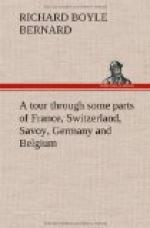* * * * *
CHAP. II.
The approach to Paris is certainly very striking, but considering the vast extent of the city, its environs do not present an appearance of any thing like that bustle and activity which marks the vicinity of the British metropolis: nor do the villas which are to the north of Paris display that aspect of opulence which distinguishes those streets of villas by which London is encompassed. The gate of St. Denis, under which we passed, is a fine piece of architecture; it stands at the end of a long and narrow street, which is but ill calculated to impress a stranger with those ideas of the magnificence of Paris of which the French are perpetually boasting, although it conducts him nearly to the centre of the city. I afterwards found that this is the most crowded quarter of the city; the houses are from six to eight stories in height, and are almost universally built of stone.—But although it must be admitted that this entrance to Paris is one of the least distinguished, yet at the same time it must be observed, that there are but very few streets in that city which have much to boast of in point of appearance; they are mostly narrow, and the height of the houses necessarily makes them gloomy. They are (except in one or two new streets at the extremity of the town) extremely incommodious for pedestrians, there being here no place set apart for them as in London; hence they traverse the streets in perpetual dread of being run over by some of those numerous carriages which are continually passing along with an impetus which raises just apprehensions in the mind of the foot passenger, that he may share the fate of Doctor Slop, if nothing more serious should befall him; as in avoiding the carriages it is no easy task to keep clear of the kennel, which is in the centre of the street; the descent to it is rapid, and it is rarely dry even in the warmest weather.
It is when seen from one of the bridges, that Paris appears to most advantage, as many of the quays are unquestionably very handsome, and decorated with many elegant edifices. The Seine is in no part so much as half the width of the Thames, in some places not a fourth part, as it forms two islands, on one of which stands the original city of Paris. Its waters are united at the Pont Neuf, on which stands the statue of Henry IV. looking towards the Louvre, which he founded. The view from this bridge is without comparison the most striking in Paris, and is perhaps unequalled in any city, for the great number of royal and public edifices which are seen from it; and inconsiderable as is the Seine compared with many other rivers, yet nothing has been neglected to render its banks striking to the passenger.—Many of the bridges (of which I think there are altogether 16) are handsome, particularly those of Austerlitz and of Jena, constructed by order of Buonaparte.




